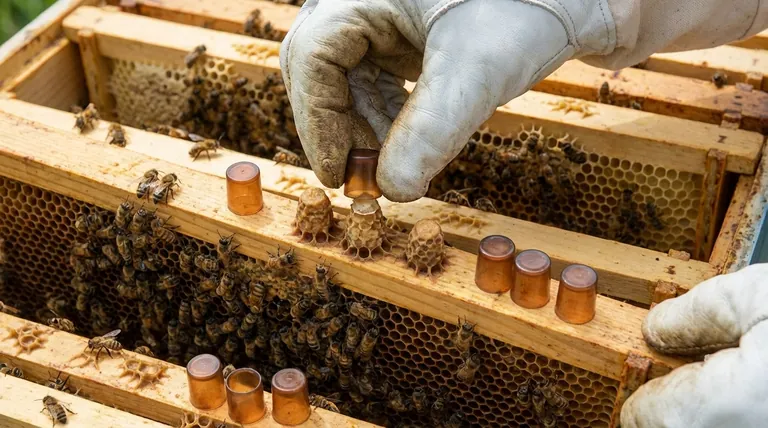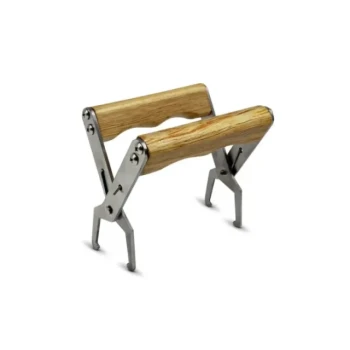The fundamental purpose of a queen cell protector is to shield an unhatched queen from her rivals. When a beekeeper places multiple queen cells in a hive, the first virgin queen to emerge will instinctively seek out and destroy all other queen cells to eliminate her competition. A protector physically blocks her from doing so, safeguarding the other developing queens.
The core problem is a new queen’s instinct to kill all rivals. A queen cell protector is a simple tool that allows a beekeeper to override this instinct, increasing the odds of successfully raising a new queen and providing more control over colony management.

Understanding the Queen's Instinct for Survival
To grasp the value of a protector, you must first understand the brutal reality of queen succession. A colony can only have one laying queen, and nature ensures the strongest survives to fill that role.
The First Queen's Mission
A newly emerged virgin queen has two primary drives: mate and eliminate all rivals. She will patrol the comb, listening for other queens, and will use her stinger to kill any she finds, including those still developing within their wax cells.
Why Beekeepers Intervene
Beekeepers often introduce multiple queen cells into a queenless hive or a small nucleus colony ("nuc"). This is a form of insurance. A single cell might fail to hatch, or the virgin queen might be lost during her mating flight.
Using several cells dramatically increases the probability that at least one viable, mated queen will successfully take over the colony. The protector is the key to making this insurance policy work.
How the Protector Works
A queen cell protector is a small plastic or wire cage that fits over the queen cell, leaving the bottom tip exposed. This simple design is critical to its function.
Preventing Lateral Attacks
A queen chews her way out of the bottom of her cell. An emerged rival queen, however, will sting through the side wall of a cell to kill the occupant. The protector forms a barrier around these vulnerable side walls.
Allowing Emergence
Because the bottom of the cell is left open, the developing queen can emerge normally. She can exit the cell and move freely, but she cannot turn around and attack the other protected cells from the side. This gives the beekeeper a window of time to manage the newly emerged virgin queens before they inevitably fight.
Common Pitfalls to Avoid
While effective, protectors are not a magic bullet. Their successful use depends on understanding their limitations and the colony's biology.
Timing is Everything
A queen cell must be introduced to a colony when it is near hatching. If you introduce a very young, uncapped cell, the bees will likely tear it down and consume the larva. Protectors are for mature, capped cells.
A Temporary Truce
The protector only works for a short period. Once multiple virgin queens emerge, they will eventually find and fight each other to the death. The tool gives the beekeeper time to inspect the hive, select the best queen, or move the "extra" virgins to other hives that need them.
Applying This to Your Goals
Your strategy for using queen cell protectors should align directly with your beekeeping objectives.
- If your primary focus is requeening a single hive: Use a protector on a backup cell to ensure you get a viable queen if your primary cell fails.
- If your primary focus is creating multiple nucs: Use protectors in a strong "cell builder" colony to allow several virgins to emerge safely before you move each one to a separate mating nuc.
- If your primary focus is grafting and large-scale queen rearing: Protectors are essential for protecting your investment and maximizing the number of queens you can produce from a single batch.
By managing the natural and ruthless competition between queens, these simple tools give you a powerful advantage in directing the future of your colonies.
Summary Table:
| Purpose | Key Function | Benefit to Beekeeper |
|---|---|---|
| Prevent Rival Attacks | Creates a physical barrier against emerged virgin queens. | Protects your investment in multiple queen cells. |
| Allow Normal Emergence | Open bottom lets the queen hatch naturally. | Ensures a healthy, viable queen can lead the colony. |
| Provide Management Time | Creates a temporary truce between emerged queens. | Gives you time to inspect hives and create new nucs. |
Ready to take control of your queen rearing and colony growth?
As a commercial beekeeper or equipment distributor, your success depends on reliable, high-quality supplies. HONESTBEE specializes in wholesale beekeeping equipment, including durable queen cell protectors, designed to maximize your queen production and operational efficiency.
Let our expertise support your apiary's success. Contact HONESTBEE today to discuss your wholesale supply needs and discover how our products can help you build stronger, more productive colonies.
Visual Guide

Related Products
- Brown Nicot Queen Cell Cups for Breeding Queen Bees Beekeeping
- JZBZ Push-In Queen Cell Cups for Beekeeping
- JZBZ Type Wide Base Plastic Queen Cell Cups for Base Mounting and Queen Rearing
- JZBZ Langstroth Queen Rearing Frame for Beekeeping
- Stainless Steel Queen Grafting Tool for Beekeeping and Bee Queen Grafting
People Also Ask
- Why is it important to select a healthy larva less than 24 hours old for queen rearing? Maximize Queen Quality and Colony Strength
- How many cells are given to a nucleus? Understand the One-to-One Rule in Cell Biology
- What are the signs that a queen cell is about to emerge? Master the Critical Timing for Hive Success
- What should be done with extra queens from grafting? A Strategic Guide for Apiary Management
- What is the benefit of inducing supersedure by giving a queenright colony a protected queen cell? A Seamless Requeening Method



















